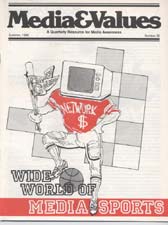Here She Comes...Miss America(n Sportswoman)
|
This article originally appeared in Issue# 36
|
Women athletes know the score, but their looks still make the headlines
"A cool braided California blonde… her perfectly tanned, well-formed legs swinging jauntily. The hair on her arms was bleached absolutely white against a milk-chocolate tan. Her platinum hair pulled smartly back in a Viking modem braid..."
No, this is not a description of a movie star or a romance novel heroine. It's a description of a professional golfer, Laura Baugh, that appeared in a 1971 Sports Illustrated article.
While the coverage of women's spoils has greatly improved over the past fifteen years, writers and commentators still tend to focus on the physical characteristics of female athletes. Even in 1983, a World Tennis article described professional tennis player Andrea Temesvari as "tennis' latest sex symbol," with brightly polished fingernails" and "magically dancing blue eyes,"
Society's notions about athletic women are reflected in the media's treatment of women's sporting events. According to Bill Gilbert and Nancy Williamson, who wrote about the subject in a Sports Illustrated series, 'Women are either heterosexual wantons or homosexual perverts. or simultaneously both."
The minimal attention paid to women's sports, especially limited television coverage, helps to encourage such notions, researchers believe. According to sport sociologist Ellen Gerber, television coverage of women's sports constitutes less than 1% of the total sports programming in the United States.
Female athletes are basically in a "no-win" situation when it comes to media coverage. Few women's sports are telecast because few professional sports exist for women. And where women have excelled, it has been in individual sports like golf, tennis or gymnastics, rather than team contact sports which drive a media-fed cycle of coverage, fan loyalty, and "big-bucks" advertising.
Even when the occasional women's golf or tennis tournament is broadcast, the tendency to heighten women's physical attractiveness is apparent. Since sponsors of "women's products" like Avon and L'eggs are lined up for these programs, economic concerns are also a factor. They want their products to be associated with attractive women.
Male athletes, however, are judged on their performance, not their looks. So coverage often emphasizes the aesthetics of women's spoils but the athletics of men's events.
For example, in coverage of the 1984 Winter Olympics, a feature segment during the women's figure skating focused on Peggy Fleming in a "video fashion show" of skating costumes from the 1920's to the 1980's. Later during the men's event, Dick Button demonstrated the artistry and skill of the compulsory school figures.
Although men may watch women's sporting events, they don't seem to take them as seriously as the traditional male team sports and championships. Thus, descriptions of attractive women may be intended to pique their interest. "Magically dancing blue eyes" apparently possessed an attraction lacking in a woman's serve and volley technique.
Women's participation gets more exposure in the Olympics than anywhere else. During the 1984 summer and winter games, women competed in more events than ever before. But coverage still reflected stereotyping. For example, in displays tracing male and female ski team training courses, the different slopes were denoted by pink and blue lines, just like the identifying blankets in a hospital nursery.
Sports broadcasting will probably continue to emphasize contact team sports played by men. But as collegiate sports programs for women expand, opportunities for coverage may also grow, especially by cable and regional sports networks. This, in turn, will promote more serious attention to women's athletics and quality of coverage may also develop. The process will be accelerated if we question the current assumptions governing coverage of female athletes and ask for change.



